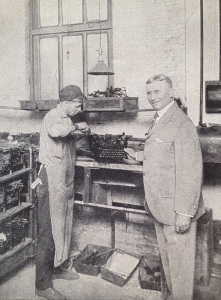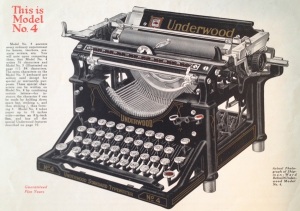
It’s obvious that no matter how good a typewriter might be – that is to say, no matter how good the design, the condition, the maintenance – it’s really no better than its printing. No one wanted any correspondence coming out of an office to look sloppy, and bad or dirty type on a machine could easily lead to that appearance if allowed.
This is exactly why we see the 1924 image above; in the plant of the Shipman-Ward Manufacturing Company, we see founder E. W. S. Shipman inspecting the work of one of his craftsmen who is soldering new type onto the type bars of Underwood machines deep in the process of being completely rebuilt. The technician has a torch in his right hand, supplied by lines visible on the wall (with cutoff valves); a type bar is being held in a fixture or jig on his bench while a new type slug is being applied. More type bars are hanging on pegs at his station, on the wall board. Shipman himself, having been in the industry for many years, truly knew that the print work of his machines was perhaps the final aspect a buyer could or would analyze and knew it had to be perfect.
Of course, such an operation wasn’t always due to damage; many rebuilders offered special keyboards (such as mathematical) or foreign language keyboards, and these might often have required the operation seen here (as well as the application of the appropriate ‘keyboard’, or set of keytop legends to match the type slugs.)


